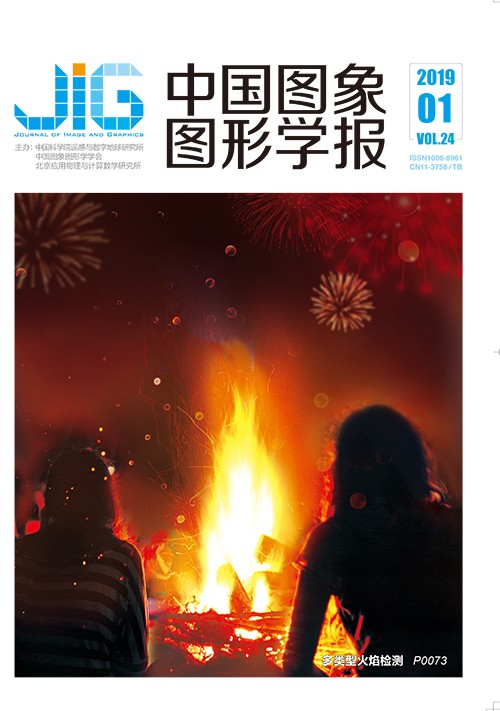
基于局部连接度和差异度算子的水平集纹理图像分割
摘 要
目的 复杂纹理的图像分割一直是图像分割的难题,现有的一些纹理图像分割方法主要通过提取图像确定方向的灰度变化特征或者提取图像的局部灰度相似性特征得到特征图像,从而进行纹理图像的分割,然而,自然纹理中普遍存在局部形态相似和方向不确定的现象,导致现有方法不能准确地分割纹理图像。方法 本文提出局部连接算子和局部差异算子来描述局部纹理的形态相似性和局部纹理的差异度。一方面,通过设定一定阈值,将局部区域的灰度差异分为两类,分析两类差异的分布特征,从而提取图像的形态特性及局部连接度算子;另一方面,设置一种无方向性的灰度差异分析算子,提取图像局部的灰度差异值从而得到局部差异度算子。两个算子结合以更好地提取纹理图像的局部特征,然后通过融合局部相似度特征、局部差异度特征和灰度信息,构造水平集能量泛函,进而通过最小化能量泛函实现纹理图像分割。结果 相比基于Gabor变换、结构张量、局部相似度因子的纹理分割方法,提出的局部算子能够更好地区分自然图像的不同纹理区域,且对实验图像的平均分割准确率高达97%,远高于其他方法。因此,提出的模型对于自然纹理图像具有更好的分割效果。结论 本文提出了两种新颖的纹理特征局部描述子:局部连接度算子和局部差异度算子,能够有效地提取纹理特征,且有一定的互补性。实验表明,提出的方法对于复杂自然纹理图像具有良好的分割效果。
关键词
Level set method based on local connection operator and difference operator for segmenting texture images
Zhou Li, Min Hai(Department of Information Engineering, Hefei University of Technology, Xuancheng Campus, Xuancheng 242000, China) Abstract
Objective Images with complex texture features are difficult to segment. Many methods, such as Gabor filter and structure tensor, have been proposed to segment texture images. However, these methods present a number of drawbacks. For example, methods based on Gabor filter must set multiple scales and directions, and the desirable scale and direction parameters are difficult to select. Methods based on structure tensor must set two fixed directions to analyze intensity variations. However, many texture images include irregular direction features. Moreover, utilizing only the intensity variation information is an inadequate strategy. Morphology similarity and direction uncertainty often exist in nature texture images. Existing methods cannot be utilized to accurately segment nature texture images. Method Considering the morphology similarity and direction uncertainty of local texture patterns, we proposed the local connection and difference operators to extract the texture features of images. On the one hand, by setting a threshold for each local region, the local connection operation can be used to analyze the intensity distribution and texture morphology features. On the other hand, by considering the intensity variation trait of texture images, the local difference operation can be utilized to extract the local intensity variation. The local connection operation and the local difference operation are complementary. Then, by combining the local similarity and local difference features with the intensity information, the level set energy function was constructed and further minimized to obtain the final segmentation results. The main advantages of the proposed method can be summarized as the following two points. First, the morphology feature was proposed to analyze the local intensity distribution feature of texture images. The intensity distributions of texture images are uncertain for each object region. Thus, extracting the morphology feature of a local region is of great significance. Second, the two proposed operators are complementary. Using only one feature to segment complex texture images is a challenging task. The morphology and intensity difference features can jointly segment images, suggesting that the proposed method can be robust for different texture images. Result We verified the effectiveness of the two operators by comparing it with other operators, such as Gabor, structure tensor, extended structure tensor, and local similarity factor. Specially, we first analyzed the extraction effects of the morphology feature by comparing the proposed local connection operator with methods based on Gabor filter, on structure tensor and extended structure tensor, local similarity factor. The extracted feature of the local connection operator can be used to efficiently discriminate the object and background regions. Then, the local difference operator was used to compare the proposed approach with traditional texture feature extraction methods. The local different operator can accurately extract the local intensity variation. In addition, we conducted three comparison experiments to confirm whether the proposed method can achieve a better segmentation effect than the methods based on Gabor, structure tensor, extended structure tensor, and local similarity factor. Finally, we tested the robustness of the proposed method for different initial contours and images. The segmentation accuracy of our proposed method exceeded 97%, which was considerably higher than that of other methods. That is, the proposed operator is more effective in discriminating the different texture patterns of images. Conclusion We proposed two complementary operators, namely, the local connection operator and the local difference operator, to effectively extract texture features. The two extracted features are complementary and can be jointly utilized to segment texture images. Finally, we validated that the proposed method can obtain better segmentation results for natural texture images.
Keywords
|



 中国图象图形学报 │ 京ICP备05080539号-4 │ 本系统由
中国图象图形学报 │ 京ICP备05080539号-4 │ 本系统由